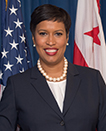Washington, DC
District Youth Show Decline in Childhood Obesity, School Violence
(WASHINGTON, DC) – Results from the 2012 District of Columbia Youth Risk Behavior Survey (YRBS) released today by the Office of the State Superintendent of Education (OSSE) and the DC Department of Health (DOH) indicate that D.C. youth are showing signs of progress across several health-related behaviors including reductions in obesity and all forms of school violence. For the first time since 2007, the biennial YRBS evaluated a representative sample from both District of Columbia Public Schools (DCPS) and Public Charter Schools (PCS), compiling data from over 20,000 District students in grades six through twelve.
“This survey, paired with data from the District of Columbia Comprehensive Assessment System (DC CAS) Health and Physical Education exam, positions D.C. to create cutting-edge health policies and practices to ensure that our youth are leading healthy lifestyles as they move through school and transition into adulthood,” said State Superintendent Jesús Aguirre. “We look forward to using these findings to continue our work through collaborative inter-agency programming, and further demonstrate that DC has made the mental and physical well-being of our children a priority.”
The data reveals a hopeful outlook on childhood obesity in the District as results show a 2 percent reduction in the number of obese high school students while data from the U.S. Centers for Disease Control and Prevention (CDC) indicate that the national rates of obesity among youth aged 12-19 remained unchanged between 2007 and 2011. Since 2010, D.C. has worked to combat obesity and hunger through the D.C. Healthy Schools Act – a landmark law designed to improve the health and wellness of all District public school students.
“We are pleased to see the decline in the District of Columbia childhood obesity rates, proving a coordinated approach with community partners and government can yield positive health outcomes,” said Dr. Joxel García, Director DC Department of Health. “However our work is not yet finished, the District is committed to the continued development of effective programs that address the social determinates of health leading to poor nutrition and physical inactivity.”
Highlights from the survey also show that District of Columbia Public Schools and public charter school students have seen significant reductions in violent behavior on school property. Across the District, there was a 7 percent decrease in those who had property stolen or deliberately damaged on school property and a 4 percent decrease in students who were in a physical fight on school property one or more times.
The 2012 YRBS data also supports the continued provision of culturally specific support to improve health outcomes of Lesbian, Gay, Bisexual, Transgender and Questioning (LGBTQ) youth at both the middle and high school levels. LGBTQ youth are almost twice as likely to be bullied at school and to not attend school as a result of feeling scared compared to their heterosexual peers. They are also more than twice as likely to experience relationship violence, have suicidal thoughts, attempt suicide and use alcohol, tobacco, marijuana and cocaine compared to heterosexual youth.
In the District’s public education system, bullying remains a prevalent problem among students, impacting approximately 30 percent of middle school students and 11 percent of high school students. The findings around mental health also presented room for improvement, particularly among female students. Twenty-eight percent of middle school females and 19 percent of high school females reported that they had earnestly considered suicide.
Other key findings include:
- Sexual activity: Fewer middle school students reported being sexually active than in 2007, and condom use among high school students, at 70 percent, remains well above the national average of 60 percent.
- Food Access: 11 percent of middle school students and 17 percent of high school students reported sometimes, most of the time or always going hungry because there was not enough food in their home.
- Drinking and Driving: The number of middle and high school students who rode in a vehicle driven by someone else who had been drinking alcohol significantly decreased between 2007 and 2012; from 28 percent to 20 percent for middle school students and from 29 percent to 26 percent for high school students.
- Drug Use: Since 2007, high school students’ use of both marijuana and cigars/cigarillos has increased (from 21 percent to 32 percent and 10 percent to 17 percent, respectively); 20 percent of high school students and 10 percent of middle school students report synthetic marijuana use.
With the data now in hand, OSSE will work with other city agencies including DOH, the Office of Human Rights (OHR), the Department of Behavioral Health (DBH), and community partners to develop and increase systematic supports. An example of systematic supports is the augmented training provision for all early childhood providers through the American Psychological Association (APA), which will assist the District in supporting organizations and schools so that all District youth feel safe and respected. The trainings conducted in collaboration with city agencies and the APA will ensure that the Youth Bullying Prevention Act of 2012 is being met, as the Act requires all public schools, DC youth-serving agencies and nonprofit organizations that work with youth to have a bullying prevention policy.
Also, in partnership with the Department of Behavioral Health, training will be available for all District teachers and principals at public and public charter schools and licensed personnel at child development facilities on how to identify and refer students with behavioral health needs.
This data will also inform initiatives such as a close partnership with DBH, which is working to implement a resource guide for D.C. residents to access behavioral health services while also continuing a number of public awareness campaigns and training parents, family members, teachers, school personnel and peers on how to assist youth facing mental health challenges or crises.
Read the full 2012 D.C. YRBS report on OSSE’s website at http://osse.dc.gov/service/youth-risk-behavior-survey

